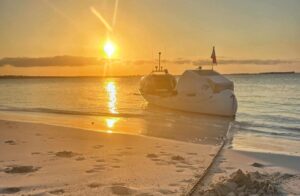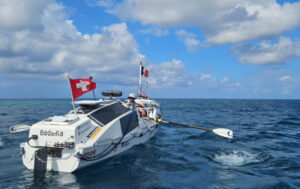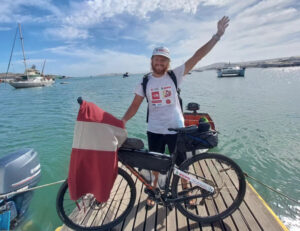Since our last ocean rowing roundup, one team has broken the speed record across the Pacific Ocean. One soloist has restarted his journey, and several crews are closing in on their finish lines.
Pacific Ocean
The Pacific Challenge – The inaugural Pacific Challenge, run by the same group that organizes the Talisker Whisky Atlantic Challenge, started on June 12. Fourteen crews and 49 rowers set off on the 4,500km from Monterey, California to Hanalei, Hawaii.
The first finisher, Kiwi Fondue, crossed the line on July 12 after exactly one month. The team finished in 29 days, 17 hours and 29 minutes, breaking the speed record across the Pacific by 14 hours and one minute. The four-man crew included Alex Brooker, Rich Henderson, and brothers Lorenz Gammeter and Alex Gammeter.
Henderson described the row as “epic to torturous to beautiful and everything in between.”
The next crew, Oceanwarrior, should finish today, July 13. The foursome only has 120km left.
View this post on Instagram
A week after starting, one crew, Row4ALS, decided to end their Pacific crossing. On social media, they only cited “personal issues.”
After a month at sea, all other crews are doing well, and some are closing in on the finish line. Many include experienced rowers who have previously taken part in the TWAC.
Overall Winners: Kiwi Fondue – 29 days, 17 hours and 29 minutes
Fastest Five – Flyin’ Fish – 2181km to finish
Fastest Four – Kiwi Fondue – Finished
Fastest Trio – HODL eEnergy – 1,092km to finish
Fastest Pair – Aloha Kai – 1,642km to finish
Peru to Australia
Tom Robinson (AU) has been rowing from Lima, Peru to Australia in stages. He first rowed to Penrhyn, in the Cook Islands, in 160 days. There, he waited four months for the cyclone season to end. He then rowed to American Samoa in 38 days, arriving on May 21.
He admits that when he arrived in Samoa, he was “ready to throw in the towel.” For the first few weeks in Samoa, he lived on his boat as he struggled with both recurring flu and the idea of continuing.
Then everything changed. Thanks to some good Samaritans, he lifted his boat out of the water onto a trailer and had a room to stay in. With a hot shower. “The Queen was still alive the last time I had had a hot shower!” he wrote. “It was the normalcy I needed to get back into the swing of things.”

Photo: www.tomrobinsonboats.com
Once rested, he spent a few weeks making minor repairs to his boat, once again determined to complete the journey. He started rowing directly to Queensland, Australia on July 2. He thinks he can make it in 120 days, but if he has to, he is ready to stop again.
“There is a swathe of large Melanesian Islands to the west, and if I do end up close enough to a beckoning, coconut-clad shore, it would be hard not to stop.”
Indian Ocean
Robert Barton – Barton (AU) is rowing from Carnarvon, Australia to Tanzania. He has now covered 95% of the 8,358km journey and should arrive in the next few days.

Photo: Robs Row/Facebook
At the end of June, he faced completely opposite challenges from the wind. One day, he was barely moving because it was so still. A few days later, a stiff breeze pushed him in circles. Saltwater started affecting the bearings in his seat so he replaced them with some spares.
He has also been having issues with his satellite phone. He can send but not receive messages. Another day, he woke up to a deck covered with dead flying fish that had beached there while he slept.
Anyone doing a long ocean row eats mainly dehydrated food. You get tired of it. Near Mauritius, the Coast Guard radioed Barton to offer him some fresh fruit. As part of his unassisted journey, he sadly had to decline.
Indi Row 23 – This team of four is rowing across the Indian Ocean from Western Australia to Mauritius. Chris Cleghorn (UK), Allan Huntly (UK), Stephan Easter (UK), and Ben Mann (AU) began the 5,927km row on May 11. They have covered 5,290km so far, and hope to finish in 70 days. That gives them eight days to row the final 640km. If they make it in less than 67 days, they will break the speed record.

Photo: IndyRow23/Facebook
Throughout the journey, they rowed in two-hour shifts. In the last week, they faced numerous challenges. For days, huge waves spilled over the sides of the boat. One of the waves was so strong that on July 7, Easter dislocated his finger. He later managed to pop it back into place.
Arctic row
Ocean Revival – Matt Mason, Matthew Inglesby, Mark Sealey, and Colin Hiscock make up this British four rowing from Tromso, in northern Norway, across the Barents Sea to Longyearbyen, Svalbard.
The entire 1,050km row will take place within the Arctic Circle. Only 13 people have completed this before. If successful, they will be the first four-person crew to do this. There are also other minor records they will break if they make it to Svalbard. Mason will be the first person to have rowed across the mid-Atlantic, north Atlantic and Arctic Oceans, and Inglesby will be the first to row the Atlantic and Arctic Oceans in the same year.
They started on July 7 and have covered 405km so far. They hope to finish within 15 days. The crew has significant rowing experience. Sealey, Mason, and Inglesby have all completed previous ocean rows. Inglesby crossed the Atlantic Ocean this year, and Mason was part of the first crew to successfully row from New York to London in 2021.
Before beginning, Sealey told The Lancashire Telegraph, “The weather will be between 0˚and 7˚C, but the arctic wind could very quickly bring that down into sub-zero temperatures. The Arctic Ocean weather is unpredictable and extremely changeable, so accurate weather forecasting will be difficult. We will row in constant daylight and in shifts of two hours on, two hours off.”
Around mainland UK
Ithaca – This all-female, six-person crew is circumnavigating mainland Britain. They set off from Tower Bridge, London on June 4 and hope to make it back to their starting point in the next few days. Emma Wolstenholme, Amy Wood, Sandra Gates, Emma Hazel, Clair Hennessy, and Margaret Ann Hodge, are all from the UK. They have covered 3,000km so far and have 220km remaining.

Photo: Ithaca/Facebook
From London, they made their way down the Thames Estuary and continued clockwise around Great Britain. Strong winds and rough seas forced them onto the anchor for 36 hours during the first week. Then they had to pass through the busy shipping lanes at the Port of Dover.
Another tricky section came at the end of June when they had to row through Pentland Firth. The channel separates mainland Scotland from the Orkney Isles. It has a tidal stream of 12 knots and is known as one of the most difficult channels to cross.






